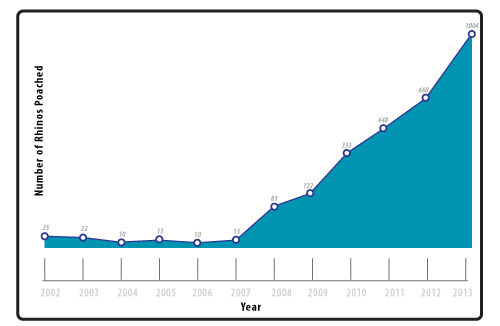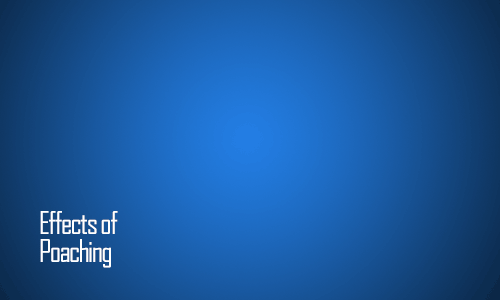Poaching of Rhinoceros The dire situation

Poaching of rhinoceros (rhinos) in South Africa has escalated to critical levels today. The situation is so dire that the remaining 2 species (northern white and eastern black) of rhinos have been listed on the International Union for Conservation of Nature (IUCN) Red List of Threatened Species. With species such as the Africa's western black rhino officially extinct, the need for effective measures to save these animals is ever so prevalent today to ensure their survival.
The effects of poaching are numerous and widespread, affecting not just the animals but also the society. With crime syndicates and terrorist groups involved in these activities, the impact on the society is truly detrimental. This austere situation has encouraged organisations from around the world to lend a helping hand to curb this problem.
The poaching of rhinos can be traced back to early 20th century when there was an approximate population of 500,000 rhinos worldwide, dispersed throughout Africa and Asia. Yet, despite intensive efforts in conservation and the implementation of new laws and regulations, the poaching of rhinos has escalated exponentially over the years as illustrated by the statistics. In 2011, the western black rhinos was officially declared extinct by the International Union of Conservation of Nature (IUCN).
Focus will be placed on South Africa as it is home to 83% of Africa's rhinos and an estimated 73% of all wild rhinos worldwide. In 2013, there were a staggering 1004 rhinos poached in South Africa alone which approximates to almost 3 rhinos killed a day.
Since one of the main habitats left for these existing rhinos is Kruger National Park, most of the current conservation efforts are focused there. However, from a statistical point of view, despite efforts in conservation, the situation is bleak as poaching has continued to increase exponentially.
Effects of Poaching

Ecosystem
Rhinos are an indigenous population of South Africa and a sharp decrease in its population will have a domino effect which will cause great instability to the delicate ecosystem of the region. Furthermore, plants rely on animals for both pollination and seed dispersal. The removal of herbivores from an ecosystem alters seed dispersal and seed predation patterns which might lead to defaunation in the ecosystem.
Social
Poaching and violence go hand in hand. With most poachers carrying weapons to hunt and kill rhinos, there are bound to be clashes between them and anti-poaching rangers. This is supported by a statement from Save the Rhino with regards to poachers who were shot dead. Unnecessary loss of life due to poaching evidently has an adverse effect on the social situation of the region as violence due to armed groups is increased and innocent people may get caught in the crossfire.
Economic
Eco-tourism, which contributes a significant 7% to the economy of South Africa, is badly affected by poaching. The fear of venturing into areas with armed poaching and the bad publicity gained from the poaching of rhinos reduces the number of tourists visiting the region. In a report conducted by the Wildlife and Environment Society of South Africa (WESSA), they concluded that, "the current poaching tide will start to threaten tourism in South Africa unless brought under control". This, in turn, will decrease the need for jobs such as safari guiding which reduces employment opportunities.
Political
Research conducted by the United States International Conservation Caucus Foundation (USICCF) has found that the terrorist group Al-Shabaab engages in rhino poaching activities to fund its terrorist plots and arms stashing. The problem is seen to be so severe that President Barack Obama has set aside a sum of 10 million USD to help park rangers in a bid to help tackle 10 billion USD worth of wildlife trafficking.
The Weather Balloon Solution The Eye in the Sky

The aim of the design as a whole is to act as an early detection system of poachers entering Kruger National Park on vehicles at night. This is achieved by the seamless integration of the various components to create a robust and reliable solution, whilst maintaining a cost-effective edge. These components include:
Balloon
Balloon lifts payload to an altitude of about 120m to conduct effective aerial surveillance.
Battery
High energy density and lightweight Tracer lithium polymer battery provides stable and continuous power for operation of camera and transmitter up to 12 hours.
Thermal Camera
TAU 2 thermal camera with 7.5mm lens maximises field-of-view(FOV), enabling better tracking of poachers at night when poaching is most rampant.
Transmitter
5.8GHz transmitter provides the crucial wireless link between the camera and the base station where video processing is carried out.
Video Processing
By eliminating static background and leaving behind dynamic objects, intelligent Gaussian Mixture Model(GMM) effectively identifies poachers' movement from received thermal imagery.
Responsive Alert system
Alert system implemented by the Java client warns the user of potential threats and its location.
Area of Operation Where we operate
Kruger National Park home to last wild rhinos in the world. We aim to monitor the 410km border between Mozambique and the Kruger National Park.
